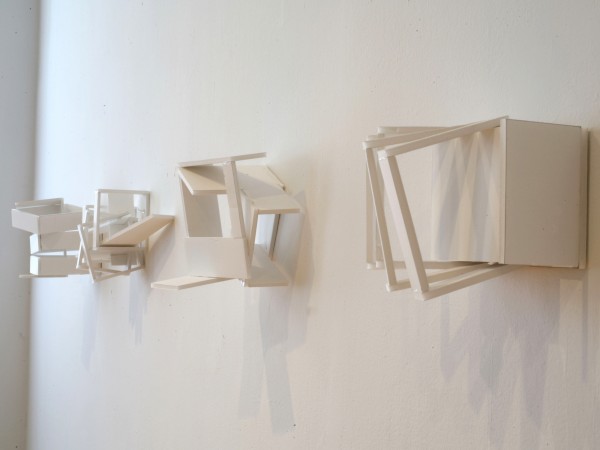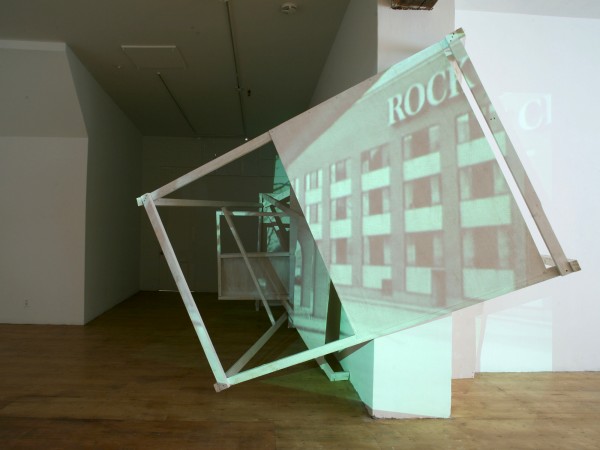A discreet vapour emanates from the asphalt, although the cars are barely moving, the noise of their running motors and the smoke from their mufflers continues unceasingly. In spite of the fact that the highway counts numerous lanes, the imperceptible movement of the motor vehicles combines itself with the expressions of resignation and impatience of their drivers. Under the robust structure of the highway a lost stare contemplates the impossible task of traversing the thoroughfare, ironically isolated, he glances in front into a useless leftover space produced by the colossal highways’ structure. We are in any city, going to any place, a familiar landscape that forms part of our everyday as urban dwellers and that repeats itself in almost every city, like a silent echo that we frequently ignore.
Have we ever asked ourselves how did this come to be? How is it that this situation forms part of my everyday?
Have we ever stepped out of the comfort capsules that our cars represent and analyzed this phenomenon from another perspective, a pedestrian point of view? n environment that doesn’t seem conceive by human beings, where there is no sense of ergonomics or proportion, where, inhabiting, the most essential of human activities, seems an impossible challenge.
Even though the city is filled with contradictions and complexities, it continues to be a strong magnet that attracts a great majority of people. The greater part of the world population lives within an urban centre and migratory tendencies indicate that this number will continue to increase due to the strong pull of economic, political and social interest that attracts people to cities. This fact has transformed cities into fast moving and changing spaces that suffer abrupt continuous transformations in their form and shape. Therefore, leading cities to compromise their identities, their principles and their essence while their poles of interest move and disperse their limits.
What we refer to, as urban centres in reality are a series of different “cities” united by transitory leftover spaces that we have learned to accept and domesticate. These spaces are a new challenge to our understanding of the concept of what a city is. They are ever changing spaces with no personal identity that repeat themselves in most large urban centres around the world, like an “island” that repeats itself in the collective memory of our societies. This all constitutes transitory spaces that we mainly utilise to move from one “city” to another in our extremely polarized urban centres.
These transitory spaces that pretend to link our urban centres in reality divide and separate them, creating frontiers within the urban tissue of our cities, splitting neighbourhoods and creating useless leftover spaces. These spaces are mainly the leftovers of a huge automobile infrastructure that leaves on its way huge useless spaces that have no specific use or intention hence no particular identity.
Thanks to its nature, we have associated these spaces with the post-modern notion of “non-space”, an ideological posture that denies a well-known and accepted concept, questioning its essence and revelling its particular complexity.
Our cities contain hundreds of these “non-spaces” which interrelate with one another creating huge conglomerations that occupy great extensions of our urban surface. The conglomeration of these “non-spaces” creates consequently what we can refer to as a “non-city”, the denial of the concept of city. Following this same train of thought we can argue that by producing and inhabiting the “non-city” we become “non-humans” and our thoughts, words and actions are governed by a “non-understanding”.
These conditions manifest themselves in the fact that while we concentrate ourselves in making our cities more comfortable and functional places, paradoxically we are also doing exactly the contrary. We are creating space with no particular use, intention or identity, spaces that divide and disintegrate our cities and dehumanize the life of its dwellers.
It is this inherent complexity, this apparent particularity that nourishes the artistic discourse of Eduardo Valderrey. This spatial phenomenon of our urban centres influences the creative reflections of the artist, nourishing his project Malpais. Malpais is a particular notion with which Valderrey makes reference to the visible geographic hostility of these areas of our cities.1
Contemporary badlands, territories created and provoked ironically by ourselves while pursuing a more comfortable and efficient lifestyle, making these spaces a part of our everyday. Aside from the aesthetic and formal stimulation that these spaces may instigate, the “non-city” proposes new challenges in the way in which we conceive, inhabit and understand the city, questioning its essence.
How many times have we stopped for an instant to admire this discreet herb that has apparently sprouted from the heart of a sidewalk’s concrete? A fragile little plant that has found its way to grow in the middle of a paved street and that grows slowly, smiling, knowing itself a winner of a silent battle. Maybe with time, this tiny plant grows into a big fruitful shady tree, filling us, without knowing why, with a fresh scent of hope.
In this same manner, Eduardo Valderrey’s work, sprouts like this herb in the middle of a paved street, naturally perturbing its surroundings. Creating a new architecture inside an existing one, installing structures that perturb the existing architecture and using them as screens to project video images that describe the contemporary urban badlands accompanied with rhythmic percussive sounds, Vaderrey deconstructs our notions of the articulate city. His work encourages the questioning of our preconceived notions of the city, making us reflect upon the kind of spaces that we inhabit. In this way, Valderrey’s Malpais is filled with stimulations that lead us to ponder about the cities we live in and the form in which we would like to inhabit them, thus blooming a yearning to change them.
The idea and possibility of altering our cities in the name of common well being is not new. To the contrary, it has been an unfulfilled wish that has accompanied us since the last century. This social desire for transformation has remained a utopia and has been treated by sociologist, philosophers, urbanists, architects and artists alike. In his essay Quotidien et Quotidienneté2, Henri Lefebvre reminds us that in order to change life we have to change society, space, architecture and the city. In this way, the discourse to change the city is a well-known one. One will have to insist then on the fact that in order to be able to change the city one has to change its relating concepts. While discussing his notion of concept-city in his book L’invention du quotidien3 (The invention of the everyday), Michel de Certeau reminds us of the intrinsic symbiosis that exists between the city and its concept. The first step in changing the city is redefining its concept, thus redefining our concepts of urbanism and architecture.
The way in which we understand the concept of living is the heart of this conceptual question about the city. Caught up in the inertia of modernism, which we have not fully analysed and questioned, we continue to live under the premise that gives the automobile unmeasured importance, considering it an essential part of the well being associated with living in a city. It is not until we profoundly question this principle and ponder about its benefits and harmful aspects for our cities, that we are going to be able to start rebuilding our concept of the city and break with our polarizing inert tendencies to disarticulate our urban centres pushing us to inhabit hostile spaces willingly in the heart of the urban badlands that we nourish everyday.
Paradoxically, like Dr. Frankenstein, we have created a creature that has become an uncontrollable monster. The so-called metropolitan area is made up of both cities and non-cities and seems to grow by itself, like it has a life of its own. Trapped and paralyzed by its inert movement we witness how our urban centres, far from re-creating its spaces, offer us hostile environments lacking real intention. It is said that these spaces reflect the absence of personal, social and collective identities and repeat themselves in any place at any given number. Lets keep in mind that this “loss” of identity is reminding us of a profound collective amnesia that prevents us from remembering the basic fact that we create ourselves the spaces and environments that we inhabit and it is ourselves who create that which we refer to as city.
If at certain instances, it seems like we have created an urban frankenstein, it is our duty to nourish it or destroy it. For the most important part of recovering our identity is acknowledging our capability and responsibility to transform the place in which we live in.
- Through out the history of exploration, human beings have encountered all kinds of territories. They founded both abundant fertile lands that fitted their needs and promoted their well being, and hostile inhospitable lands that did not served their purposes and where often avoided and respected. It was this second kind of territories that English explorers called badlands, concept that has been translated into Spanish as malpais to describe this kind of hostile environments of practically no use for human beings.
- Lefebvre, Henri. 1972 “Everyday and Everydaylife”, Encyclopaedia Universalis, vol. 13, Paris: Claude Grégory editions. p. 152
- Certeau, Michel de. 1970, The invention of the everyday. Paris: Gallimard editions. 416 p.

